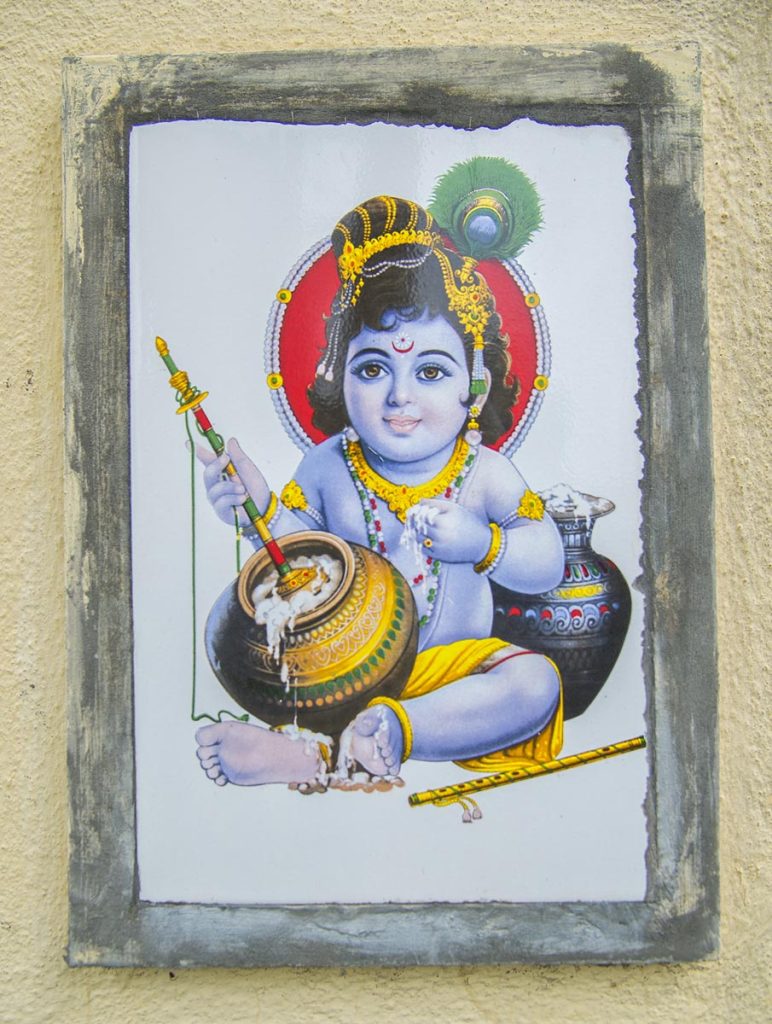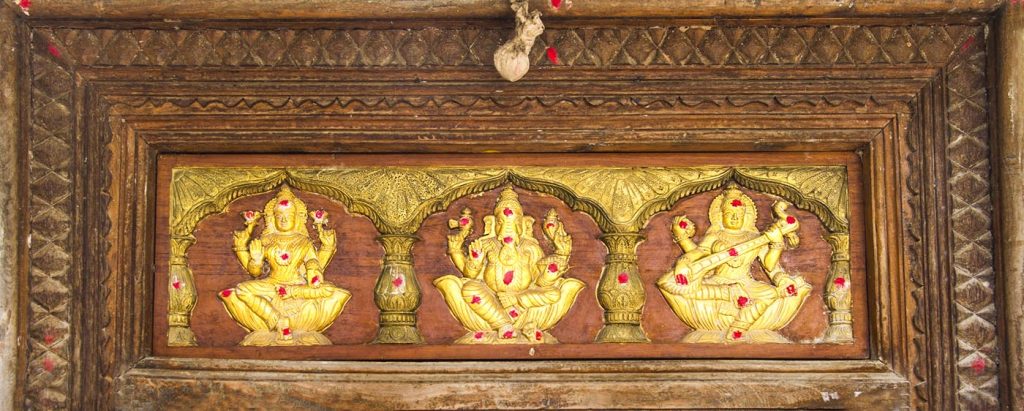From exuberant hues, to images seeking celestial blessings and protection from unwanted influences, villagers boldly adorn even the most modest of dwellings
Photos and Text by Anne Petry
India is one of the most religious countries in the world, as well as one of the most colorful—this is known by everyone. Less known is that the Southeastern state of Tamil Nadu could be a prime symbol of India’s vivid beliefs and picturesque faith. Let’s discover this vibrant state, where Hinduism is a living religion, with ancient customs deeply engraved in the rural psyche.
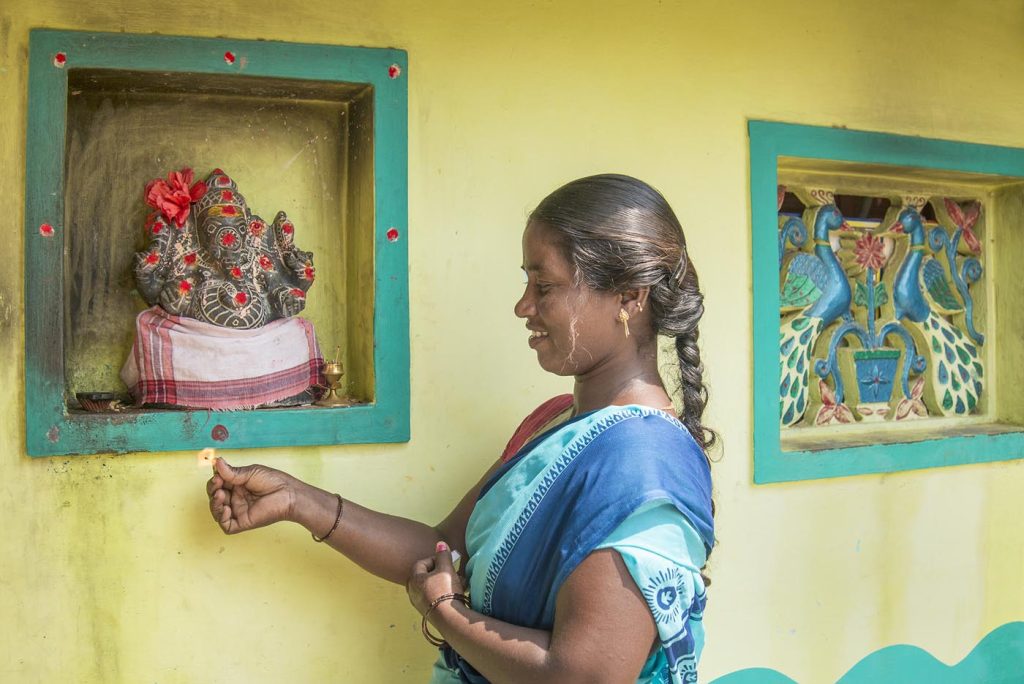
One of the main gateways into Tamil Nadu is Chennai, formerly known as Madras. With 11.5 million inhabitants, this is one of the nation’s most populous cities; but in such a gigantic modern municipality, it is difficult to sense the pulse of traditions and folklore. So, whoever wants to see and feel the authentic Tamil Nadu has to leave Chennai behind, drive to the countryside and, ideally, take a scooter to wander through the surroundings’ hidden tracks.
This is where you catch a glimpse of the typical “village lifestyle.” You can walk with farmers going to the fields, chat with women working in front of their homes, get unforgettable smiles from boys in uniforms coming from school and see young girls with braided hair cycling back home. These scenes, which Westerners may know only from movies, are snapshots of India’s rural daily life.
Even they work hard and have long days, the local people are always happy to see new faces and take care to welcome each and every visitor and make them feel at home. Venda, who lives in a small hamlet, declares: “It is not very often that we have outsiders here, so whenever someone comes, we are honored. It is our duty to open our door in order to offer a chai and some dry biscuits.” Those families might not have much, but it is rare to spend a day strolling through Tamil villages without being invited by locals to visit their homes and sit with them for a while.
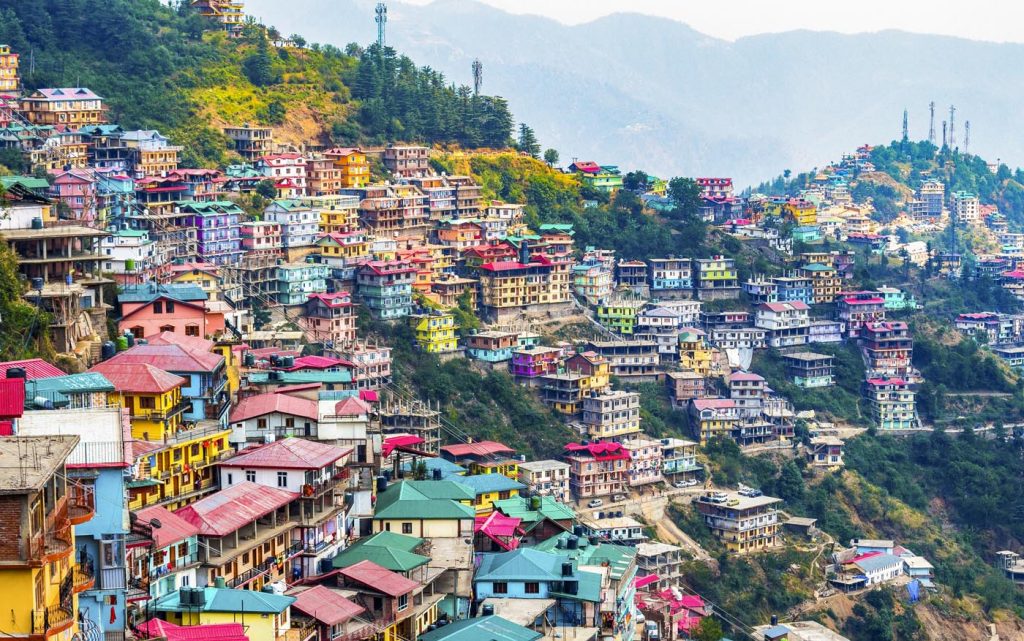
Here, one can discover an unusual architecture—low roofed houses painted with bright colors, so that no two homes look the same. In Western countries, we’re accustomed to seeing uniformly colored buildings, but traditional village houses in Tamil Nadu are quite the opposite.
In fact, it seems as though hundreds of rainbows have showered the homes, leaving their colors on the walls, which are adorned with three, four, or even five different shades. Prem says: “Nowadays construction styles are different from what they used to be in the past, they are higher, with balconies and big windows, but one important thing remains, colors! And I don’t think that it will change, as colorful houses are fully part of our architectural and cultural heritage.” It seems, though, that locals have adapted traditions to modernity by incorporating colors not used in the past, like fluorescent hues.
Besides the multicolor facades, homes display Hindu Deities on their outer walls—a statue of Ganesha, a framed picture of Hanuman, or a carving of Lakshmi on a wooden transom. Nagaraj tells me: “You will not find many houses in Tamil Nadu that don’t have religious images painted or drawn on their walls, as these play an important role in our architecture.”
The affection and love that Indians have for their Gods can be as close as the relationship between parents and children or two best friends. With the faith of devotees being so strong, it feels natural for the population to display their beloved divinities on their homes.

It is a common belief that a deity “works” for their followers, and by submitting wishes, one can hope to receive happiness and security in return. Sita confirms, “Starting my days with a puja is a way to talk to God, to thank Him for this new day. I believe that by doing so, He will watch over me and my family all day long.” Pujas can be as simple as lighting a lamp and offering flowers to the Deity, or they can be more elaborate and detailed, with chanting and abundant offerings. Devotees see expressing their devotion as a way to access the divine and make their house a sacred sanctuary, a refuge from the worries of the world.
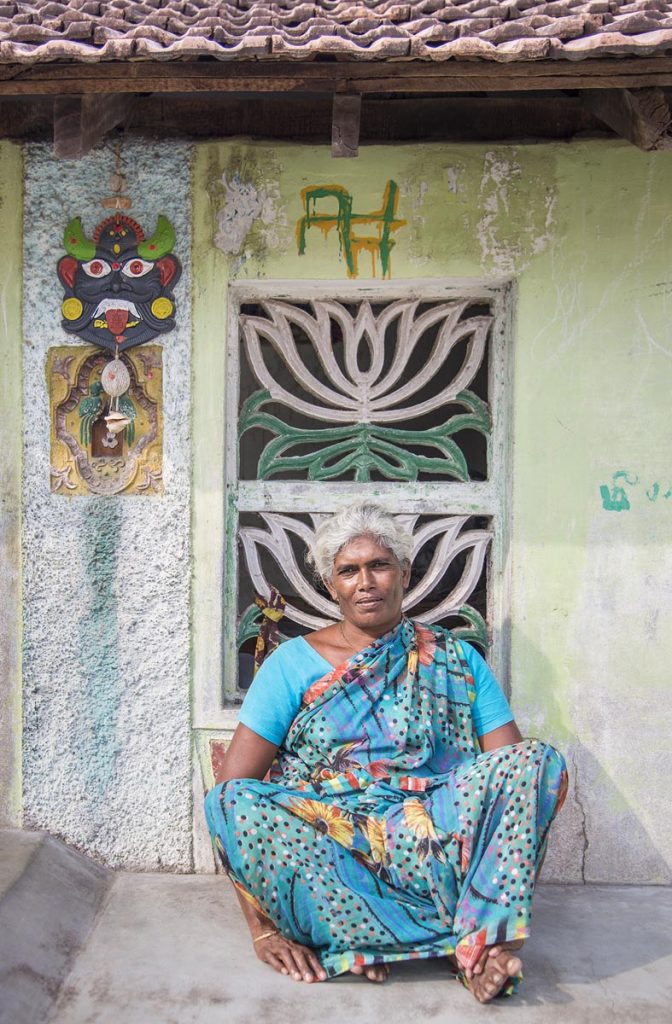
This longing for protection is still especially vivid in the countryside. Tamil Nadu, despite currently being the most industrialized state in India, has a historical legacy of being an agricultural state, heavily dependent on river water and monsoon rains for sustenance. One drought, and crops can be devastated; one insect invasion, and the work of a whole year can disappear.
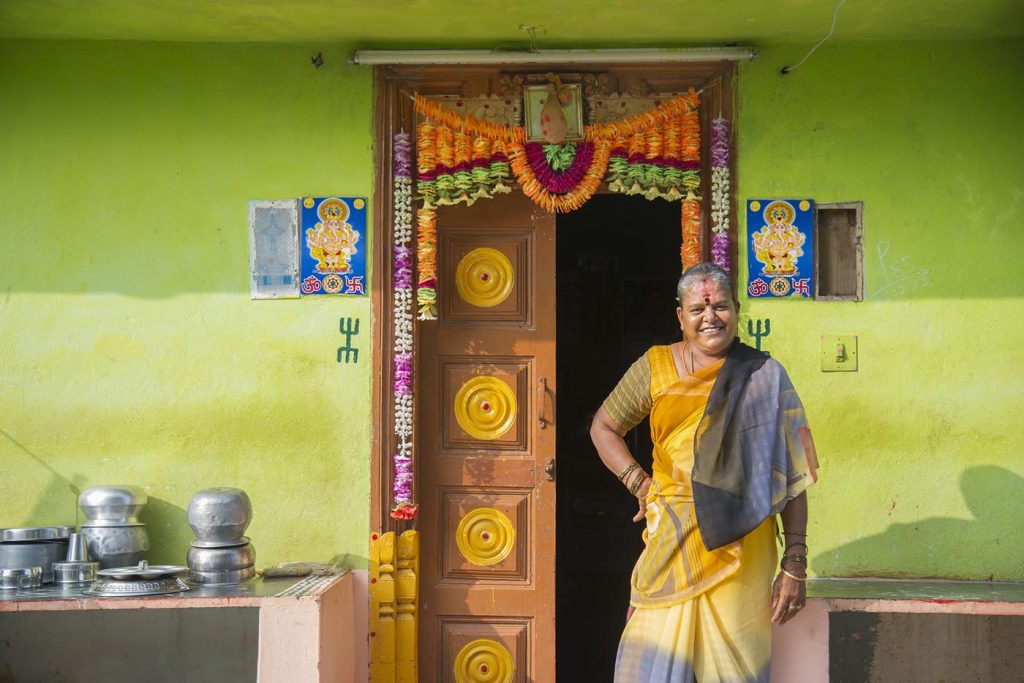
Nowadays, fear of a climate disaster is still strong, and so are the superstitions and traditions! In order to protect their crops, it is common to see the population setting up in fields scary masks or figures made of straw and clay. Having received an education to be a rational person who believes only in what is visible and in what can be defined, I sometimes struggle to understand the purpose and the meaning behind these masks; but just like religion, superstitions are intimate and personal beliefs that don’t require explanation; they only have to be respected.
A famous and intimidating mask that can be found in almost every rural household is the ugly Drishti Bommai. Meant to ward off the evil eye, the mask is placed directly above the main entrance of the house. With the same intention, a green nameless symbol is often painted on exterior walls (photo, page 63).
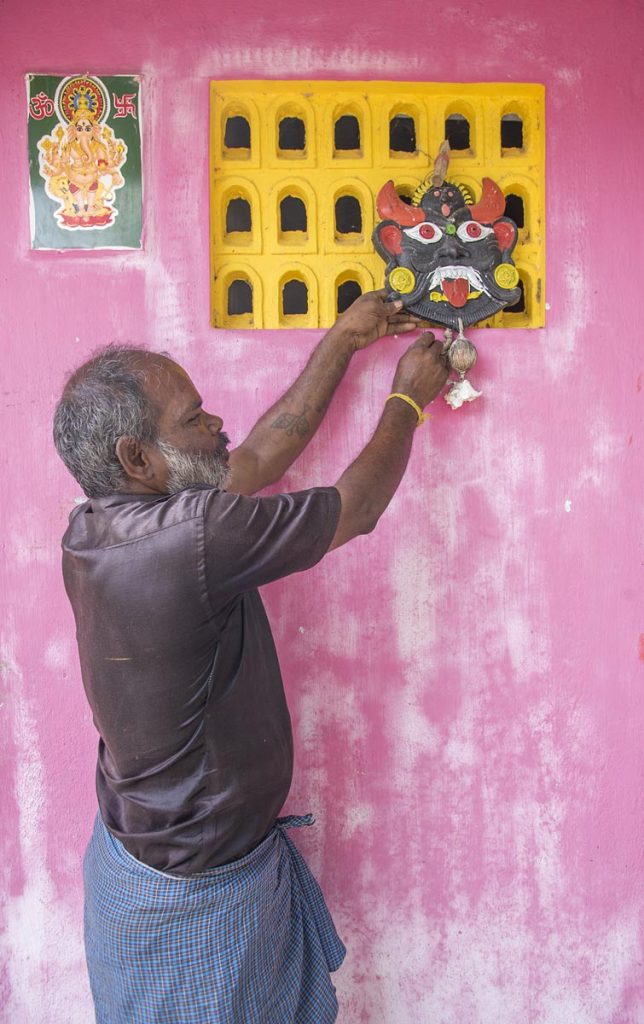
Even though precise meanings behind these symbols may be unknown, as per tradition, women continue to draw these patterns. Geetika, 26, says, “As far back as I remember, I have seen my grandmother and then my mother painting a green symbol on our house walls in order to keep our family safe. From what I know, even though it looks like a man, it actually represents a trident with two extra prongs. I am not very sure about the precise meaning, but if my elders painted this symbol, it must be important, and so I honor our heritage by drawing it also.” Perhaps it is related to Bhairava, a fierce protector form of God Siva.
However, even the most entrenched traditions are subject to change in modern times. Daya, who is 67 years old, confesses: “When I was young, we used tree leaves to draw this symbol, and after a few minutes, it turned green. Nowadays, even though it is less natural, we use green paint because it is more practical and resistant.” This is a way of adapting ancient beliefs to the realities of the 21st century!
Conclusion
In the Western world, daily life is often treated as one thing and religion as another, like two separate, unrelated domains. In India, it is quite different. Tamil Nadu is the perfect example, where mystic beliefs and Hinduism are closely intertwined with everyday life and traditions. Religion is incorporated as a way of life, a mode of thought that through centuries has become second nature. The tremendous faith and devotion of the Indian people is one of their most distinguishing features. It brings hundreds of surprises to every traveler who decides to visit India, as each corner reveals a big temple or a small altar, all erected in the name of Hindu Deities.
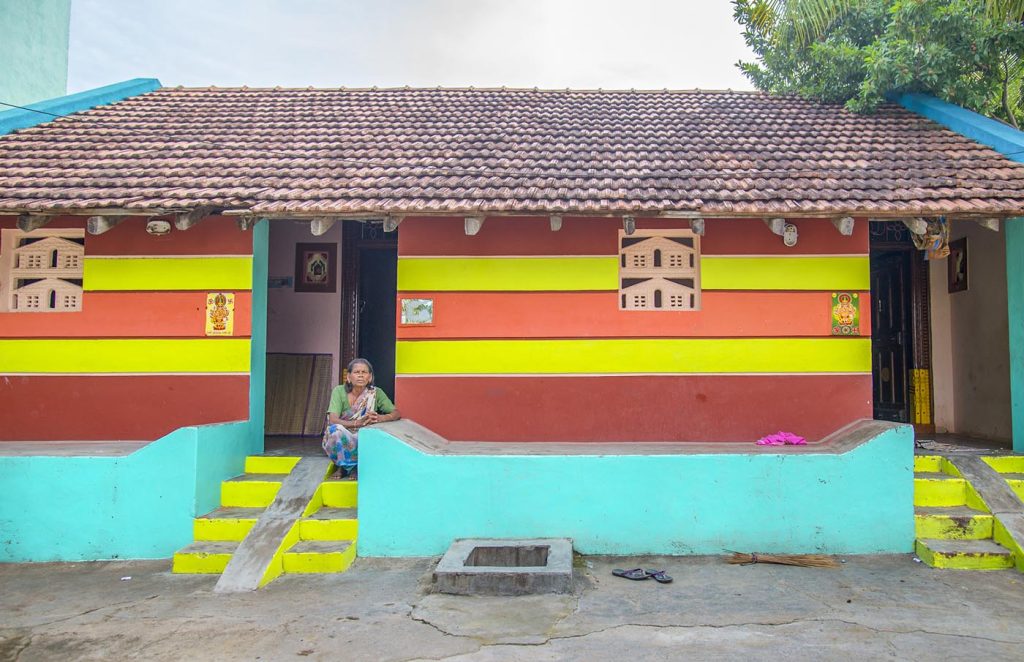
A Lexicon of Painted Divinities
Lord Ganesha
Though Ganesh’s worship dates back to Vedic and pre-Vedic culture, He emerged as a distinct Deity, in clearly recognizable form, in the 4th and 5th centuries CE, during the Gupta period. He is the most well known and the universally-worshipped God in Hinduism.
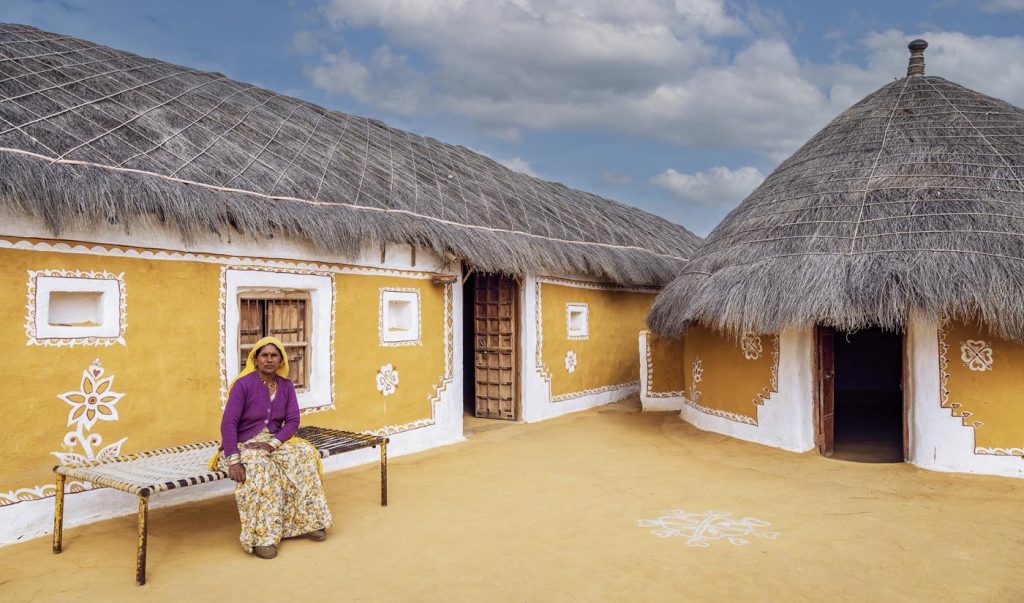
Known by different names, such as Ganapati, Vinayaka, Vignesvara or Pillaiyar, Ganesh’s icons are found throughout India. He is invoked on all occasions, whether religious or social. Ganesh is widely revered as the remover of obstacles and, more particularly, as the Lord of Beginnings, patron of arts and sciences, and the Lord of intellect and wisdom. It is believed that worshipping Him first brings harmony to our home, removes all complications and actions are always crowned with knowledge and accomplishment.
According to the Brahmanda Purana, Ganesh has all universes present in Him, the past, the present and the future. Lord Ganesh’s best-known forms have between two and 16 arms. The serpent is a common feature in Ganesh iconography. It is said that the snake is used as a sacred thread, wrapped around the stomach as a belt. The mouse is interpreted in several ways but generally it symbolises desire. Also, the mouse is destructive and a menace to crops. Ganesh overcoming and mastering the mouse demonstrates His function as the Lord of Obstacles.
By riding a lion and holding weapons, Ganesh offers protection and blessings to his devotees. The lucky cross, called swastika, is associated with the good fortune given by Lord Ganesh. This sign of auspiciousness has crooked arms to represent the path towards our objectives that is not always straight, but filled with changes. The sound Om is considered to be the first creative sound of the universe. It is also chanted aloud and recited in silence each day by Ganesh’s devotees, bringing with it His blessings…
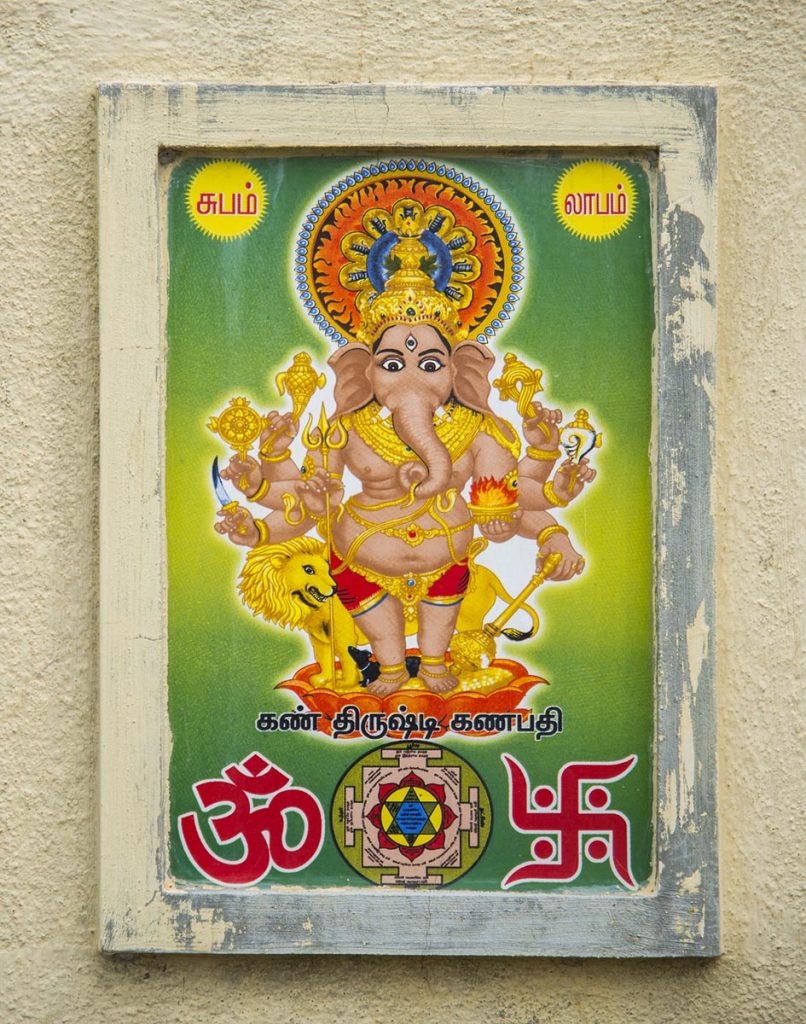
Goddess Lakshmi
The Vedas have developed the concept of a Goddess as the embodiment of prosperity, success and peace. Lakshmi is the Goddess of Wealth. But wealth that does not connote mere material well being, nor money, which is temporary. Real wealth is divine wealth, it is knowledge, wisdom, being fearless and purity of mind and heart. Also, on a more human level, wealth is having a good health, a loving family, affectionate parents and children and it is having a house, land, grains and cows. Mahalakshmi symbolizes auspiciousness, She is the giver of prosperity, splendor and glory; She is known to be the bestower of all benefits.
By praying to Lakshmi and by Her grace, it is also believed that one who has a true deep longing for liberation, can attain achieve mukti. Goddess Lakshmi can manifest Herself under eight different forms representing eight different aspects of prosperity. Gaja Lakshmi, Daughter of the Ocean (picture below), is one of her eight manifestations. She is described as emerging from the Sea of Milk when the devas and asuras were churning it. She came out of the ocean sitting on a lotus, with two lotuses in Her hands. Two elephants appeared from the ocean with a pot of milk and poured it on Her. Gaja Lakshmi is the protector of humanity, promoter of peace and prosperity.

Lord Hanuman
Hanuman has more than a thousand names and as many qualities: as Janasrayah He provides shelter to people, as Sankat Mochan He eliminates distress and brings happiness, as Sripradah He is the bestower of splendour, as Ajarah He immunes from old age, and as Virah He is the conqueror of enemies in a battle.
He is a very popular Deity, revered by all and often, He is a role model for mankind. Temples dedicated to Him are found all over India. In addition, wherever there is a temple of Ram, Hanuman’s murti is sure to be there. Known for His loyalty and devoted service to Lord Rama, He can fly and change form at will. He is the most valiant among the warriors and possesses divine knowledge. He is recognized for strength and dynamism, and for always meeting emergencies with a clear mind. People revere Lord Hanuman for His unique combination of physical strength and valour with superb intelligence, foresight and wisdom.
One of the most primal needs for humans is to feel safe and protected. The idea of submitting to a divine being and seeking His shelter is prevalent in most religions, Hinduism included. As Hanuman saved Ram, for the masses He quickly became the perfect guardian to preserve them from wild animals, thieves and other dangers. God Hanuman is often represented sitting in an attractive and powerful posture, having large earrings and other beautiful golden ornaments.

Lord Krishna
Krishna is one of the most widely revered of all Hindu divinities. Across many traditions He is worshiped as an avatar of God Vishnu and also as a supreme God in his own right. In the Bhagavad Gita, Krishna is the divine speaker and appears as the teacher of Arjuna.
The name “Krishna” means “black,” “dark,” “dark blue”or “dark as a cloud.” Krishna is the very source of bliss. He is the symbol of pure happiness, joy, and love; qualities that are the greatest enemies of the ego. In fact, if there always has been a conflict between ego and love, it is because the ego melts and disappears when love dawns within. Lord Krishna is often supplicated to resolve complex problems and it is believed that He knows how to solve nasty situations in the best interest of all concerned.
He is sometimes depicted as a child, crawling on His hands and knees or dancing with joy, a ball of butter held in His hands. Sometimes He is a young cowherd boy with a dark blue complexion playing a flute or a prince giving philosophical direction and guidance. Lord Krishna has dominated the pages of Indian cultural history for centuries and one can say that He has influenced the Indian thought, life and culture in a very profound way.
